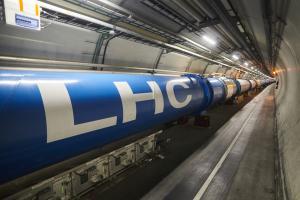Centro de Excelencia Severo Ochoa
Menú
Buscar

A new data collection period begins today, Tuesday, July 5, for the experiments at the Large Hadron Collider (LHC) at CERN, after more than three years of work updates, improvements and maintenance. The beams have already been flowing around CERN's accelerator complex since April, when the LHC and its injectors were turned on. LHC operators are ready to announce "steady beams," a condition that enables experiments to turn on all subsystems and begin collecting data that will be used to analyze the collected physics. It is expected that the LHC will operate 24 hours a day for approximately 4 years at a record energy of 13.6 trillion electron volts (TeV).
We will focus the proton beams on the interaction points at a beam size of less than 10 microns, thereby raising the collision rate. In Run 3, we will analyze 280 reverse femtobarns, an increase that could lead to discoveries further down the road," says Accelerator Director Mike Lamont. An inverse femtobarn is equivalent to approximately 65 trillion proton-proton collisions.
The four major experiments at the LHC have received significant updates to their data selection and reading systems, with new detection mechanisms and computing infrastructure. During Run 3, ATLAS and CMS detectors expect to record more collisions than in the previous two physics cycles combined. It is expected that the LHCb experiment will increase its data collection rate by a factor of ten, while ALICE will increase collision recording by a factor of 50. By improving the detectors of each experiment, we will be able to collect significantly larger samples of data and of higher quality than we were able to do during past periods of operation.
As a result of increasing the data sample and using higher collision energies, Run 3 will further broaden the LHC's already diverse physics program: research collaborations on experiments will examine the Higgs boson with unprecedented precision, will observe previously unobservable processes, and will improve the precision of measurements taken on many known processes that address fundamental questions, such as how matter and antimatter interact. Additionally, it is hoped that researchers will be able to study the properties of matter under extreme temperatures and densities. In addition, scientists will search for dark matter candidates and other new phenomena by either conducting direct search or indirect search, in the latter case by more carefully analyzing the properties of already known particles.
"We look forward to further observations about the decay of Higgs bosons into second-generation particles such as muons. The result would be a complete revolution in the Higgs boson saga, validating for the first time that even second-generation particles gain mass through the Higgs mechanism," says CERN theorist Michelangelo Mangano.
"ATLAS will measure the strength of the Higgs boson's interactions with matter and force-carrying particles with unprecedented precision and investigate whether the Higgs boson decays into dark matter," says Andreas Hoecker, ATLAS spokesperson.
An interesting topic of study is the study of rare processes in which lepton flavor asymmetry (an unexpected difference between electrons and their muon parent particles) has been observed in LHCb data collected during previous LHC periods.
"This third cycle with our new detector will allow us to improve accuracy by two and confirm or exclude deviations from lepton flavor universality," says LHCb spokesperson Chris Parkes. The theories explaining the anomalies observed by LHCb also predict new phenomena in different physical processes. They will be studied in ATLAS and CMS as well. "Our complementary approach is essential: if we can confirm new phenomena in this way, we may make important discoveries in particle physics," says CMS spokesperson Luca Malgeri.
As a consequence of the ALICE program, which will study heavy ion collisions, it will be possible to investigate, with unprecedented precision, the quark-gluon plasma (QGP), which existed in the first 10 microseconds after the Big Bang. "Our goal is to move from observing many interesting properties of the quark-gluon plasma to quantifying these properties and relating them to their dynamics," says Luciano Musa, spokesperson for the ALICE experiment. As part of the studies, a short period with oxygen collisions will be included for the first time, with a view to exploring the appearance of QGP-like effects in other collision systems.
Several experiments at the LHC, including TOTEM, LHCf, MoEDAL with its new MAPP subdetector, and FASER with its newly installed MAPP subdetector, are also poised to explore phenomena inside and outside the Standard Model, such as neutrinos and cosmic rays.
CERN will broadcast Run 3 live through the following link and its channels and social networks starting at 4:00 p.m. (CEST). During live commentary in five languages (English, French, German, Italian and Spanish) from the CERN Control Center, viewers are guided through the various stages of accelerator operation, from the injection of particles to collisions at four parallel points where detectors are placed. Afterwards, there will be a question and answer session with CERN experts.
Social media